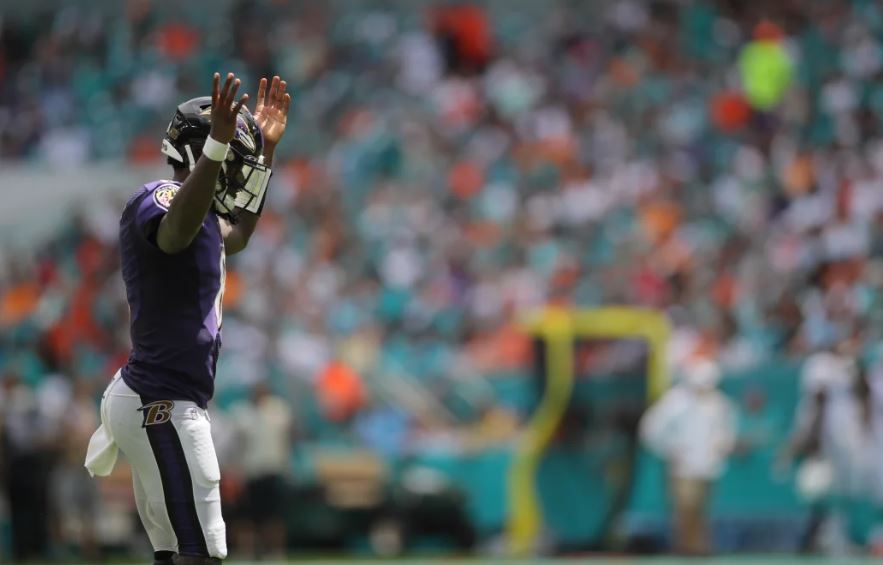Recognizing strengths, maximizing efficiency would elevate Ravens offense
According to the general consensus permeating through Ravens Twitter, quarterback Lamar Jackson will be standing in the pocket and firing 40-50 passes a game this coming season, navigating a high-octane passing offense that will supplement an historic running attack, and the Ravens will only fall short of their dreams because — let me check my notes — the Titans acquired Julio Jones this past weekend.
Hang on. That was a ridiculously long sentence. Let me get my wind.
Here’s the deal, though. The Ravens are not going to sling the ball around 40 to 50 times a game. Did they appear to upgrade their pass-catchers this offseason? Indeed. Are they hoping to get the passing game working at a much-more efficient clip? Without a doubt. Are they going to shelve everything they’ve been building for the past several years so @DundalkBuford394216249 can yell at Cleveland and Kansas City Twitter accounts about the Ravens developing a high-flying passing attack?
No. No, they are not.
The Ravens are going to continue to build around their most obvious strength on offense — and that is the two-way skillset of Jackson. He simply doesn’t operate an offense in a cold, surgical manner like Tom Brady. He doesn’t drop 65-yard rainbows into the welcoming hands of streaking receivers like Patrick Mahomes. He doesn’t fire 30-yard outs while subtly slipping out of pressure like Aaron Rodgers.
But, guess what? None of those guys can do what Jackson does, either. He moves with a style and explosion that conjures memories of prime Michael Vick, and he has the ability to complete passes at a “plus” level. So, if you find yourself with a quarterback who has a skillset that literally nobody in the world today possesses, well, ask yourself why you’d want to build an offense that didn’t consistently take advantage of those unique skills.
Nobody is arguing that improving the efficiency of the passing offense shouldn’t be a top priority. During the Ravens’ magical 2019 season (you know, before the playoffs faceplant), the team threw the ball 27.5 times a game, at a clip of 7.6 yards per attempt, per ESPN stats. It produced a humble, but effective, 201.6 yards passing a game, which contributed to a whopping 407.6 yards a game of total offense. The machine was humming.
Last season, there was a drop-off, and the Ravens threw the ball about two times less a game, at a rate of 7.2 yards per attempt — almost half a yard per pass less than in 2019. The team only generated a league-low 171.2 yards passing a game, and they produced 363.1 total yards a game. That’s more than 40 yards less per game than the season before.
If the Ravens can increase their pass-load to 30 attempts a game, and get back to that 7.6 yards per attempt figure, we’re talking about 228 yards per game, which would most likely soften some of those heavy fronts they’ve been against in playoff games, and open up things even more in the run game.
The team added Ben Cleveland and Kevin Zeitler at guard this offseason, while sliding Bradley Bozeman over to center. In theory, this should solidify the interior line and allow the Ravens to put even more pressure on opponents in the run game. Monday’s extension of Gus Edwards, along with the assumed ascension of JK Dobbins and Jackson’s unique skills, provides plenty of optimism for this Ravens offense to capably run the ball down the throat of the majority of opponents.
And it should also help out in the passing game. Pressure causes problems for quarterbacks, but probably even more so up the gut, as opposed to the edges. Not only is there a giant defender coming at your head if you’re the quarterback, but that interior push also can change your landing spot when throwing, which impacts accuracy.
If opponents gang up on the Ravens run game, don’t be surprised to see the team respond with Dobbins, Mark Andrews, Marquise Brown, Sammy Watkins and Rashod Bateman. That’s four receivers capable of creating separation, and a running back that can tote the rock and gash people if the defense backs up at the line. It also sets up those pass-run options for Jackson when he can drop back five steps, eye one particular route and, if it’s not open, he can take five years off the back end of a defensive coordinator’s life expectancy by tucking away the ball and running downfield, as defensive backs busy themselves chasing the Ravens receivers around 20 yards away from scrimmage.
There are things Jackson brings to the game that other quarterbacks simply can’t. Yes, by all means, the Ravens need to improve both the efficiency and explosiveness of the passing game. But it’s critically important they don’t forget who they are in the process, and that they don’t let their most unique advantage — the legs of Lamar Jackson — wither and die in an offense that doesn’t fit his weaponry.









